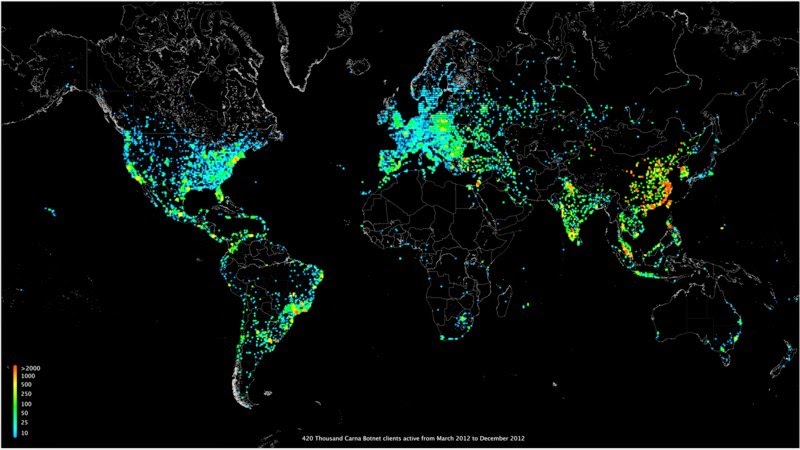| Connecting devices, furniture and even your body to the internet is at the core of the Internet of Things (IoT) trend. Currently, without a standard platform the technology is in it's infancy, but as this article shows, some major market factors are coming into play. |
The Internet of Things (IoT) basically entails the connection of physical ‘things’ with the internet. Everything becomes inter-connected, which creates a network comparable to the neural system of the human body. The only factor limiting the possibilities is our imagination, as the potential of this industry is enormous. It is estimated that, in 2020, 30 billion things will be connected to the internet, which generates revenues of 7.1 trillion dollars. In 2013, ‘only’ 9.1 billion objects were connected with the internet, which resulted in revenues of 1.9 trillion dollars. Obviously, the upside potential of the IoT is enormous and cannot be neglected.
 |
| The massive long term revenue potential of the IoT (Source: Deutsche Bank) |
In this article, I will first elaborate on the potential and then the timing of this trend. Then, I will discuss the four tech-giants who are striving for market shares in this industry. Lastly, I will conclude with describing the different layers of this industry and some more concrete investment opportunities.
Potential
Grasping the total potential of the IoT is difficult and may be best achieved by giving an example.You wake up and based on the weather forecasts, your underfloor heating system is enabled automatically. At the same time, your coffee is made remotely, based on your alarm and you check when and what medicines to take. You lost your keys, but since they have a sensor you can easily find them. When you leave with your car, it knows where you need to go based on your calendar app and knows where the empty parking lots are.
At present, this may seem science fiction, but it may become reality in the near future. Apart from this personal example, even more far-fetched inventions could be thought of. The healthcare sector can be revolutionized: home automation can enable elderly to live at home longer and patients with cardiac arrhythmia can stay out of hospitals longer by remotely reading a patient’s biometrics. Moreover, the environment could benefit hugely, for instance, by installing smart streetlights. On a larger scale, industries can manage energy and material use more efficiently. In a nutshell, the possibilities are endless.
So why now?
Home automation is not a new concept. Actually, the first ideas on home automation originate from over half a century ago. At present, companies are already capable of digitalizing your house, Legrand is one of them. Legrand is a French industrial which is a world leader in systems and products for electrical installations and information networks. This technological knowledge enabled Legrand to enter the home automation business. However, the costs of home automation have been high so far. This caused demand never to have gained momentum but this is likely to change. Various reasons arise why this momentum could be achieved in the near future.First of all, the prices of sensors have decreased steadily from $1.20 to $0.60, which lowers the barrier to place a sensor. Another point is the increasing smartphone and tablet coverage, these devices could function as the necessary dashboards. Lastly, we can observe a clear shift in research on the IoT from hardware to software. This signals that R&D on hardware is suffering from decreasing returns to scale and that investments in software have higher returns. In effect, the underlying conditions seem to be met, which paves the way for serious upside potential.
 |
| The decreasing cost and energy usage of sensors are accompanied by ever larger market potential (Source: Deutsche Bank) |
The next step?
In order to accelerate growth in this sector, standardization is the key. At the moment, every tech firm aims at attaining a market share by designing their own platforms, to which all these ‘things’ are connected. All these minor individual investments do bring serious results but the footprint of these on the industry stay relatively small."What this industry needs is a standardized platform on which all tech firms can collectively build: one standard operating dashboard to which separate features can be attached. This will drastically increase the efficiency and speed of the development of the IoT." |
The clash of the Big Four
Virtually every potential participant in the Internet of Things sees that one standardized platform is needed. However, designing and implementing this platform in the near future requires enormous investments. This kind of money is only possessed by the largest tech firms, which I will call the Big Four. One by one, I will discuss these tech-giants’ individual IoT strategies.Google is establishing a general platform that can be installed on any device. They are gathering a network of third party developers for the IoT, just as they have done for the apps in their Play store. Google is undertaking many IoT initiatives, such as Android Wear, Android TV and Google Glass. All of this innovation blends seamlessly with Google’s current strategy.
Microsoft is trying to place its relative young Microsoft OS as the new standard platform. Another promising possibility is the use of current technology in smart wear. Recent tech-reports have announced that the smart-camera of Xbox Kinect probably will be integrated into smart wear.
Samsung is the market leader in output of mobile phones and tablets. This allows Samsung to start from a pole position, since they have the largest product base. Apart from mobile products, Samsung is present in your homes with televisions and washing machines. As stated earlier, the home automation business will be important within the theme of the Internet of Things. However, Samsung is really pondering between Android and its own OS, which may cause inefficiencies.
Apple has always been famous for its solid inter-product connectivity. This has resulted in a very strong Apple eco-system, which increases the probability of buying more Apple products. Sustaining and strengthening this eco-system has always been a central part of Apple’s marketing strategy. So for Apple, the IoT is a logical extension to the iOS platform and a continuation of its current strategy.
Investment Opportunities
As an investor, you have to choose how to reap the benefits of this mega trend. Investing in the Internet of Things can be done on various levels and industries. |
| The diverse Industries and Sectors where the IoT can have an impact (Source: Deutsche Bank) |
One option is choosing one of the blue chips described earlier. These are the mightiest firms, which provide the overall platform, to which smaller developers can connect their products. If they navigate into this niche successfully, these four companies will definitely see their share price rising. However, one should ask himself to which extent, because of the enormous size of these enterprises.
Investors, who seek higher returns, should look at developers who really shape this trend, especially start-ups that make applications for the Internet of Things. One should look for small companies which have a solid business model and high growth potential. Be sure to invest in them in time, because who knows what an acquisition can do for the share price and for your capital.
Another opportunity of the Internet of Things is investing in the inevitably increasing demand of materials, like sensors. If 30 billion devices will be inter-connected in less than six years, which is more than three-fold of the current amount, companies which produce these sensors will see demand rise. In this example I use sensors but this can be stretched much further. Basically every material needed will face an upswing in demand, like servers, data storage and chips.
Security is a very hot topic within the Internet of Things. Recently the first pacemaker has been hacked and the idea that someone can control your house externally frightens potential users. In short, for a comfortable and safe user’s experience, the cloud needs to be secured. Cyber security firms know this too and are already anticipating this.
If all IoT-dreams come true, the abundance of data will grow even further. This entails that server capacity has to increase drastically as well. Alongside this development, the data needs to be analyzed in order to become valuable. Algorithms need to be developed in order to process and visualize all of this information. Data facilities and analyzing and visualizing software will have serious upside potential.
Interesting Venture Capital Opportunities
For a somewhat more concrete notion, I will discuss one company per investment opportunity, for your consideration only.As stated earlier, the Big Four are trying hard to reach the status quo platform, which is a decisive determinant of success for the Internet of Things. However, mind you, that this process may not be so clear cut as it seems. Officious standards are already emerging and while it seems like Apple and Google are introducing additional accessories to its product line, they are actually setting the bar.
 |
| IFTTT Logo |
| Related articles |
Companies are aiming at supplying the material for the infrastructure of the Internet of Things. These sensors need to be smart and cheap. Some interesting startups include: Ninja, Twine and SmartThings.
Businesses active in the analytics part involve companies like Pivotal (acquired by GE), INNCOM (acquired by Honeywell) and Venty (acquired by ABB). These companies may prove to be too premature in the current phase of development for this industry.
Conclusion
The Internet of Things may very well be the next trend with mega growth potential. Provided that forecasts about the magnitude of this industry are true, the impact on our daily lives is hard to fully comprehend. Alongside this much promising industry are great investing opportunities, which are already emerging in this early stage of development; the price of materials like sensors decrease, mobile device coverage has never been so high and we see a clear shift from hardware to software. All these factors signal the transition to a new era, i.e. that of the Internet of Things. This industry with massive growth potential needs structuring and this can only be achieved via standardized platforms, which will further ignite the urge for growth and new business ideas. This standardized platform is strived for by many, especially by the larger tech-firms. This is a battle to watch closely, since the victor may become very powerful.Apart from these blue chips, one can invest in smaller companies, material suppliers, cyber-security providers, data facilities and data analytics software. Last but not least, some ideas have been provided, to conceptualize this somewhat abstract matter. Although possibilities are endless, this potential needs to be casted, especially in this premature stage of development. The players who successfully achieve this will sustain and flourish. However, companies who burn their cash too soon may never reap the benefits; timing is crucial. Therefore, this trend has to be watched closely and continuously but the fact that this trend will have a drastic impact on our daily lives is considered as inevitable.
SOURCE Reposted with permission from Foresight Investor
| By Karsten Niemeijer | Embed |
Author Bio - Karsten is currently studying finance and is a member of Risk. He organised the Risk Finance Symposium and invests on his own account. He specializes in equities, technology and emerging markets.
This article provides opinions and information, but does not contain recommendations or personal investment advice to any specific person for any particular purpose. Do your own research or obtain suitable personal advice. You are responsible for your own investment decisions.





0 comments:
Post a Comment